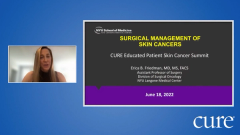
Educated Patient® Skin Cancer Summit Surgery Presentation: June 18, 2022
Watch Dr. Erica B. Friedman, from NYU Grossman School of Medicine, discuss surgery, during the CURE Educated Patient Skin Cancer Summit.
Patients with most forms of skin cancer should be prepared to see a variety of providers during their treatment journey, including surgical oncologists, according to a speaker during the CURE® Educated Patient® Skin Cancer Summit.
According to Dr. Erica B. Friedman, an assistant professor in the Department of Surgery at NYU Grossman School of Medicine in New York City, the first provider patients often see after they receive a diagnosis of skin cancer from their dermatologist is, in fact, a surgical oncologist.
“(The care team) ranges from a dermatologist who likely is the one who made the diagnosis or treats earlier, thin skin cancers to the surgical oncologist which is where we're treating early or regionally advanced or distant melanoma,” Friedman said. “And (it) spans to a medical oncologist who may treat a patient who's not a candidate for surgery. And additionally, there's a role for radiation oncology as well.”
How to Prepare for an Appointment with a Surgeon
When a patient arrives to meet with their surgical oncologist it is important that they have their pathology report, according to Friedman.
Moreover, the report should have been reviewed by a dermatopathologist, which is someone who is trained specifically to look at samples of skin, hair and nails under a microscope to diagnose disease.
This individual, she said, is instrumental in helping the surgeon determine the extent of surgery used to treat the patient — specifically, the margins, which is referred to as the border of tissue around the tumor that is removed from the patient.
“A well done biopsy plus a well-read biopsy report really allows us to stage and treat melanoma appropriately,” she said. Next slide please. Next slide.
Primary and Regional Management of Melanoma
The surgical management of local and regionalized melanoma has greatly evolved over the past three decades, according to Friedman.
The primary advancement, she said, is that less is more.
“Oftentimes, (us) surgeons don't like to hear this because we like to operate,” she said. “But the surgical treatment of melanoma has really evolved.”
The goal with surgery is to remove all of the tumor cells from the initial melanoma, she explained.
“This means we don't want any cells left behind, and we want the edges of what we remove to be clear,” Friedman said. “We would like to do this while minimizing morbidity, minimizing functional impairment and minimizing disfigurement.”
Which is why there has been a significant emphasis on less is more.
This is evidenced by, she said, numerous clinical trials over the past few decades that have compared those surgical margins across a variety of patients.
As a result of these studies, the National Comprehensive Cancer Network — an alliance of more than 30 cancer centers in the United States — developed recommendations for the surgical management of melanoma. For instance, if a melanoma is four millimeters or thicker, surgeons no longer need to remove “extremely wide surgical margins.”
However, Friedman noted that controversy still exists as to what the true optimal surgical margin is for resecting melanoma.
How the Hole is Fixed
Typically, Friedman said, the goal is to cut around the tumor in an elliptical shape to better facilitate a straight-line closure, which is described as it sounds — a horizontal or vertical scar that is not too disfiguring.
However, this is not always possible. Sometimes, Friedman noted, the area the surgeon is operating on is in a sensitive area and a plastic surgeon needs to be consulted to perform more complex closures of the resected area.
Occasionally, patients may need a full-thickness skin graft. Friedman presented a case of a patient who needed a significant portion of their nose removed. In cases where a large portion of the skin has to be removed, plastic surgeons can take portions of a person’s skin — often from less visible areas — and surgically graft them to the affected area.
For more news on cancer updates, research and education, don’t forget to

















